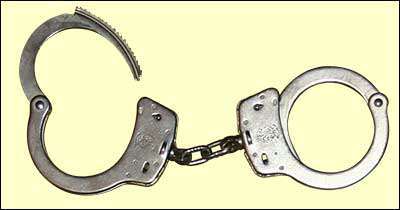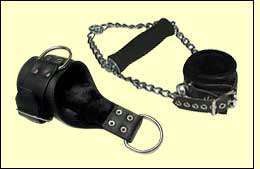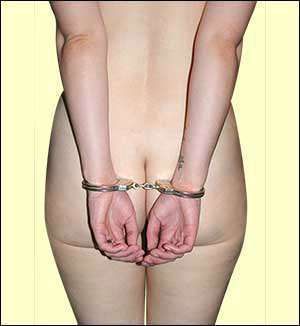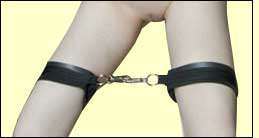Cuffs and how to use them - bondage technique and tutorial
articles and tutorials bondage tips Bondage toys and devices
Cuffs are a great time-saver in the kinkster's bedroom. They save having to learn complicated knots; they're a cinch to put on and take off; many of them are very comfortable; and they're available in a wide variety of styles, colors, and materials, so they're excellent fashion accessories as well.
You can look around and find all sorts of styles of cuffs, made of all kinds of different materials and with many different designs. They all have the same basic purpose--to wrap around a wrist or ankle (or other part of the body) in order to hold a person secure. There are several approaches to doing this, though, and several different ways they go about getting the job done.
The variety of cuffs most people are probably familiar with is the basic police-issue set of handcuffs. Handcuffs are narrow metal cuffs with a ratchet mechanism and a key lock designed so that a key is required to open them; they're made in pairs, with a short chain, bar, or hinge between them.

Handcuffs are inexpensive, easy to find, and easy to use. You can even get cheap novelty cuffs lined with fur a many sex toy stores. However, they have several significant drawbacks when it comes to sex play, and as a result, many experienced kinksters tend to stay away from them except in certain circumstances.
The narrowness and hardness of handcuffs means they can become very painful, or even cause injury, if your partner pulls or struggles against them. The pressure of the metal against the wrist can cause nerve damage if the cuffs are tightened too far or if your partner exerts pressure on them. For that reason, they're not a good choice for any sort of role-play or scenario where your partner will be struggling.
Good handcuffs are "double locking." That means they have a lock that can be used to prevent them from closing any farther; you put the handcuffs on your partner and set the double lock so that the cuffs won't open or close. This keeps them from tightening unexpectedly if you or your partner accidentally press on them.
Fetters, or irons, are a special category of cuffs that are similar to handcuffs in the sense that they're made of metal and often have a locking or ratcheting mechanism, connected by a chain or bar. Unlike normal handcuffs, fetters are usually linked by a longer chain, and some varieties are designed for use on the ankles rather than the wrists.
A few things to consider about these kinds of cuffs:
Some cuffs are available with velvet or fur lining on the inside. These are said to make the cuffs more comfortable. I've found that what they do is make the cuffs more bulky, and sometimes harder to work with, but rarely more comfortable.
All other things being equal, wider cuffs are often more comfortable than narrower cuffs of the same design and materials, especially when the wearer pulls against them, because the force is distributed over a larger area.
Cuffs with more than one attachment point can be useful for situations where you want to immobilize someone in more than one axis. For example, you can use a spreader bar to hold your partner's hands or feet apart, and also tie the cuffs down as well.
Normal cuffs should never be used to suspend a person or to support a person's weight. They are not designed for it, and can concentrate a great deal of force over a small area. If you wish to use cuffs in a way that will bear your partner's weight, you'll need special-purpose suspension cuffs designed for the job.

You'll find a few different common varieties of suspension cuff, two of which are shown here. A "grip cuff" (top) is a conventional cuff attached to a handle which the wearer holds; a wraparound cuff (bottom) is a large, wide band that wraps around the wearer's wrist and hand to support the wearer's weight.
These cuffs are intended for supporting a person's entire weight, and can be used to suspend someone completely off the ground. They're useful for more than just suspension, though. In particular, they're useful for any kind of scenario in which your partner will be struggling or resisting by force, such as a resistance play or rape play scenario, or just in general any time you might expect your partner to pull against the restraints. They look more intimidating to some people than ordinary handcuffs, but they're much safer.
A third variety of suspension cuffs is intended for hanging a person upside down by the feet, and consists of specially-designed boots fitted with a fixture from which to suspend the wearer.
There's more to cuffs than things that go around your wrists and ankles. In the next section, we'll explore some different varieties of cuffs and belts beyond the basic types shown here.

Part II: Beyond basic cuffs
Cuffs are often used to restrain a person by wrists or ankles. Their utility does not end there, though; this page explores how to take restraint a step further, and talks about types of cuffs beyond the simple handcuff or wrist cuff.
Beyond Wrist and Ankle Cuffs
Humans are a clever species, so it stands to reason that we have invented all sorts of devious variants on the theme of cuffing someone's wrists and ankles to the bed. Some of these ideas are handy to keep in your repertoire of kinky sex ideas, because you can find all sorts of solutions to the most common problems you'll find with cuffing your partner to the bed. In fact, you'll find that there are all sorts of things you can do without a bed at all!
The first problem that new kinksters often encounter is that being tied down spreadeagle really isn't that comfortable over the long term. Keeping your arms up over your head while you're lying down isn't really a very natural position, and if you do this for long enough, you'll probably find that eventually your arms and shoulders start hurting. So being cuffed or tied to the bed in a spreadeagle position works great for a while, but isn't really suitable for long-term play.
A more natural, and more sustainable, way to be bound is on your back with your legs and ankles restrained, and your wrists bound at your sides. This is actually easier than it sounds to do, and there are several different ways to go about it.

The simplest is by the use of thigh cuffs. A thigh cuff, as the name suggests, is simply a cuff that wraps around the upper thigh rather than around a wrist or ankle. Thigh cuffs, like wrist and ankle cuffs, have a tie-down point, which is most often attached to a wrist cuff to bind the wrists to the sides, preventing freedom of motion without discomfort. Thigh cuffs are usually designed to be worn for extended periods of time; when you tie your partner's wrists to his or her thighs, you can keep your partner bound for a long time while you work your will.
Variations on this basic theme,, including waist cuffs and bondage belts, exist as well. As the name suggests, these are long cuffs, usually with multiple rings or attachment points, which wrap around the wearer's waist. Cuffs can be attached to the belt, keeping your partner's hands bound at his or her sides.
Special-purpose shoulder-length gloves can be handy as well. These gloves are designed to buckle around your partner's arms so they can not be removed, and have many attachment points along them which allow you to attach them to each other, to thigh or waist cuffs, or to the sides of the bed.
You can use thigh cuffs to hold your partner's kegs apart, by attaching ropes or straps to the connection points, then fixing the other ends of the ropes or straps to the sides of the bed to prevent your partner from closing his or her legs. (Some people find that this increases the psychological impact of bondage, because it reduces freedom of motion even more than simply being bound at wrist or ankle). If you like, you can even place a short spreader bar between a pair of thigh cuffs, holding the legs apart.
While we're on the subject, spreader bars can be used in quite a number of ways to extend the versatility of cuffs and to restrain your partner in virtually any position you can imagine. At its simplest, a spreader bar is simply a rigid bar or dowel with an eye hook on each end; by attaching the spreader bar to, for example, a set of ankle cuffs, you can hold your partner's ankles apart and prevent your partner from closing his or her legs even if you do not tie your partner to the bed. Spreader bars are quite common in situations where you wish to cuff or bind your partner standing up; you do not need to tie your partner's ankles to a fixed point, as the spreader bar will often hold your partner's legs apart sufficiently for whatever you want to do.
Simple spreader bars can be made cheaply and quickly from a length of broomstick and a couple of large eyebolts; you merely need to cut the broomstick to the length you want and attach the eyebolts to each end. These spreader bars have a significant disadvantage, though, in that you can not adjust how long they are, so they can't be used for different purposes (or, sometimes, on different people).
More elaborate spreader bars are usually made of metal, and can be adjusted in length, often by sliding the ends over a center piece and then holding them in place with a removable pin:

Spreader bars with this design are a great companion to cuffs, and increase the range of possibilities available to you. Some spreader bars have built-in cuffs permanently attached to the ends, rather than eyebolts, for even easier (and more secure) bondage play.
Off the Bed
You need not restrain your partner lying down; in fact, sometimes, if you want access to both sides of your partner's body (say, for sensation play or impact play), it's advantageous not to. The suspension cuffs and suspension bar mentioned in the first page of this section are useful for more than just suspension. One fun way to use a suspension bar is to hang it from the ceiling at just about the height of your partner's outstretched arms, bind your partner to it using cuffs, then use a spreader bar to hold your partner's legs apart. Your partner will end up standing upright on the floor, arms overhead, and immobile, but without being suspended off the ground.
Of course, not everyone can be hanging things from the ceiling, and it's especially difficult if you're in some place like a hotel room...and, fortunately, human ingenuity has solved that problem as well. Doorways, of all things, make very convenient ways to tie up your partner, with no extra hardware required. All you need is a short piece of rope, about five inches long, a thick wooden dowel, and a metal O-ring.
Drill a hole through the center of the wooden dowel, tie one end of the rope to it, and tie the other end of the rope to the ring, Open the door, drape the rope over the top of the door with the ring toward the inside and the dowel toward the outside, and close the door. The dowel prevents the rope from coming through the door, and the ring provides an attachment point for the cuffs. (If you prefer, you can buy over-the-door bondage kits already assembled for you.)
Part III: What to do
So now that you know what kinds of cuffs, spreaders, restraints, and other fun items are out there, the next step is to put that to use.
You've got some cuffs. You have an assortment of clips and snap hooks and such to go with them. You have a ready and willing partner. Now what?
What to do when Your Partner is Cuffed
Many of the same ideas that apply to rope bondage, especially with regard to the psychology of bondage, hold just as true if you use cuffs instead of rope. Cuffs are more comfortable and easier to use than rope, so the psychological sense of anticipation is easier to play with as well. Some things you can do to play with this sense of anticipation:
Have your partner wear a set of wrist and ankle cuffs around the house when you're not home, as a reminder of what's in store when you do get home.
Wear the cuffs discreetly as you go about your normal routine outside the house, as a secret reminder of the things to come. This is particularly easy to do with ankle cuffs, which can easily be concealed beneath clothing.
Wear a set of cuffs while you sleep, giving your partner an invitation and an opportunity to restrain you during the night or in the morning.
When it comes to the business of actually tying your partner down using cuffs, there are several ways to go about it. You can tie a rope to the cuffs, then tie the other end of the rope to a bed frame, overhead point, or whatever else strikes your fancy; you can hook the cuffs to each other or directly to an attachment point using snap hooks, carabiners, or locks; you can use straps with a ring at each end, and hook one end of the strap to the cuff and the other end to the bed or wherever else you like; or you can hook the cuffs to spreader bars, to keep your partner's arms and/or legs apart.
One especially quick and easy way to use cuffs is with straps that have a "D" ring on each end. You can buy these, or make them from a couple of D-rings and some denim cloth, or even use rope with a D-ring tied at each end. The straps can be wrapped around bed frames or just about anything else, and the D-rings offer attachment points for the cuffs. Stay put!
One especially fun thing to do is to use straps or ropes about two or three feet long, together with a set of padlocks. Cuff your partner's wrists and ankles. Lock one end of each strap to the corners of your bed, and lock the other end to the cuffs. This gives you enough flexibility that you can turn your partner over or put your partner in any position you can imagine, but prevents him or her from leaving the bed. Once you have your partner restrained this way, you can pretty much do as you wish, and he or she will not be able to escape.
Beyond the Bedroom
Another fun technique involves cuffing your partner to the table. A large dining table works well. Loop a rope through a pair of ankle cuffs and tie your partner's ankles to the table legs, then bend your partner over the table. Attach straps or ropes to the ankle cuffs, and tie them to the opposite table legs on the other side of the table, keeping your partner stretched out over the table. This is a great position for impact play such as spanking or flogging, and allows you free access to your partner from behind.
This works well with smaller tables such as coffee tables, too. Bend your partner over the table so that his or her hands and knees are both on the floor on opposite sides of the table, then use the cuffs to attach your partner's wrists and ankles to the legs of the table. Again, this provides excellent access for impact play and for from-behind sex.
A variant on this is to lay your partner on his or her back on a small table such as a coffee table. Place a set of thigh cuffs around the upper legs just above the knees, and a strap or rope with D-rings on each end beneath the shoulders. Draw your partner's knees up toward his or her chest, and attach the thigh cuffs to the strap to hold them there. Cuff your partner's wrists at his or her sides to the edge of the table, and cuff his or her ankles to ropes or straps attached to the other legs of the table. This will keep your partner in a position on his or her back, legs apart, knees drawn up, and arms immobilized at the sides, which is a position suitable for all sorts of sex, sensation play, and impact play.
Restraint without immobilization
You can do things other than completely immobilizing your partner. Sometimes, a bit of freedom is fun to play with, especially if you like making your partner squirm. Connect a set of ankle cuffs with a short (12"-18") rope--or, for better security, use a strap and small padlocks. Lock your partner's wrists together with wrist cuffs, and run a strap or rope from the wrist cuffs to the ankle cuffs. This will allow your partner some freedom of motion, depending on how long the ropes or straps are, but still enable you to do pretty much whatever you want; it can be great fun to have your partner squirm around and try to escape as you're doing things to him or her. (Spanking, tickling, temperature play, the prickle and poke variety of sensation play, and sex are all good bets for the "doing things" part.)
Hog tie Cuffs make the old classic hog tie much simpler; rather than learning how to tie rope, you need only lay your partner on his or her front and then cuff wrists to ankles. You can do this quite simply with a couple of short straps or even with a couple of large snap hooks, though there are special X-shaped straps designed specifically for this purpose as well. Once your partner is restrained in this position, he or she is an easy target for spanking or paddling.






